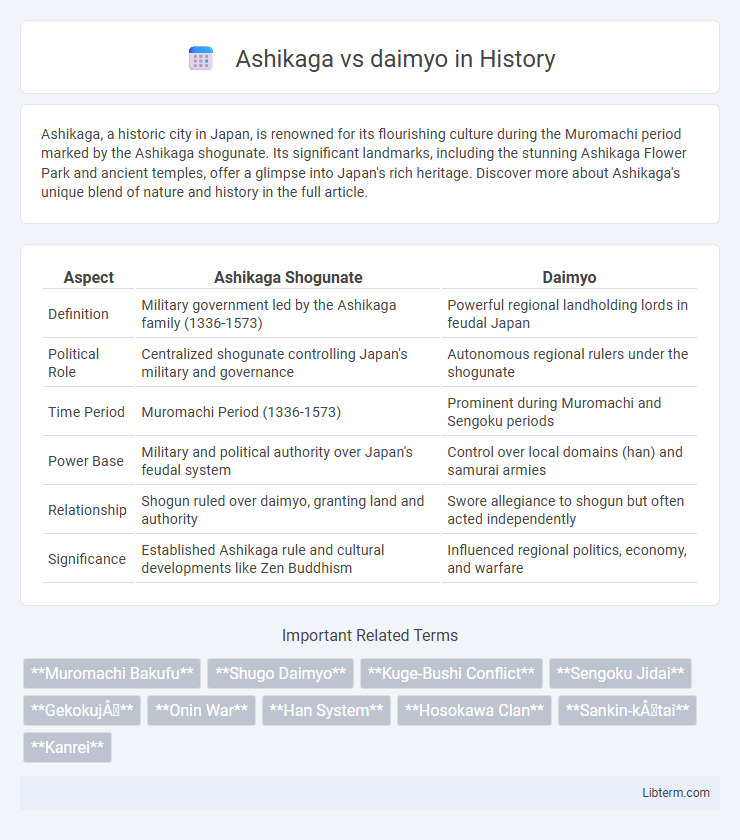Ashikaga, a historic city in Japan, is renowned for its flourishing culture during the Muromachi period marked by the Ashikaga shogunate. Its significant landmarks, including the stunning Ashikaga Flower Park and ancient temples, offer a glimpse into Japan's rich heritage. Discover more about Ashikaga's unique blend of nature and history in the full article.
Table of Comparison
| Aspect | Ashikaga Shogunate | Daimyo |
|---|---|---|
| Definition | Military government led by the Ashikaga family (1336-1573) | Powerful regional landholding lords in feudal Japan |
| Political Role | Centralized shogunate controlling Japan's military and governance | Autonomous regional rulers under the shogunate |
| Time Period | Muromachi Period (1336-1573) | Prominent during Muromachi and Sengoku periods |
| Power Base | Military and political authority over Japan's feudal system | Control over local domains (han) and samurai armies |
| Relationship | Shogun ruled over daimyo, granting land and authority | Swore allegiance to shogun but often acted independently |
| Significance | Established Ashikaga rule and cultural developments like Zen Buddhism | Influenced regional politics, economy, and warfare |
Introduction to the Ashikaga Shogunate
The Ashikaga Shogunate, also known as the Muromachi Shogunate, was established in 1336 by Ashikaga Takauji and marked a significant shift in Japanese feudal governance. Unlike the earlier Kamakura Shogunate, Ashikaga rule was characterized by a decentralized power structure where daimyo, powerful territorial lords, exercised considerable autonomy over their domains. This period saw the rise of daimyo as key political and military figures, influencing regional stability and contributing to the eventual fragmentation of centralized authority in medieval Japan.
The Rise of the Daimyo Class
During the Ashikaga shogunate (1336-1573), the decline of centralized power enabled the rise of the daimyo, powerful regional lords who controlled vast estates and maintained private armies. The Ashikaga shoguns increasingly relied on these daimyo for military support, which allowed them to consolidate their local authority and expand their domains. This shift laid the foundation for the Sengoku period's feudal fragmentation and the eventual unification under strong daimyo leaders like Oda Nobunaga.
Political Power Struggles: Ashikaga vs Daimyo
The Ashikaga shogunate faced persistent political power struggles with regional daimyo who sought to expand their autonomy and influence over local territories. These conflicts often involved military confrontations and complex alliances as daimyo resisted central Ashikaga authority to assert control over land and resources. The ongoing tension between the Ashikaga regime and ambitious daimyo significantly shaped Japan's feudal structure during the Muromachi period.
Feudal Hierarchy and Governance
The Ashikaga shogunate centralized power within the feudal hierarchy by asserting control over regional daimyo, who governed semi-autonomous domains with military and administrative authority. Daimyo retained local influence but owed military service and allegiance to the Ashikaga shogun, establishing a network of vassalage essential for governance and stability. This balance of power allowed the Ashikaga regime to maintain dominance despite ongoing challenges from powerful daimyo clans.
Military Conflicts and Alliances
The Ashikaga shogunate frequently engaged in military conflicts with regional daimyo vying for power during the Sengoku period, leading to constant warfare and shifting allegiances. Daimyo formed strategic alliances to strengthen their territorial control and challenge Ashikaga authority, employing samurai forces and castle fortifications to assert dominance. These ongoing clashes and coalitions significantly shaped the political landscape of feudal Japan, undermining centralized control and fostering regional autonomy.
Economic Control and Land Distribution
The Ashikaga shogunate centralized economic control through a system of land distribution that reinforced their authority over regional daimyo by allocating estates and rights to collect taxes, ensuring loyalty and revenue flow. Daimyo held significant autonomy within their domains but were obligated to support the shogunate's military and financial demands, creating a reciprocal economic relationship. This system allowed the Ashikaga to manage economic resources indirectly while daimyo exercised localized control over agricultural production, trade, and taxation.
Cultural Influence and Patronage
The Ashikaga shogunate played a crucial role in promoting cultural development through patronage of the arts, including the tea ceremony, Noh theater, and Zen-inspired garden design, which deeply influenced Japanese culture during the Muromachi period. In contrast, daimyo wielded regional power and sponsored localized artistic and architectural projects that reinforced their political authority and social status. Both Ashikaga and daimyo patronage systems contributed significantly to the flourishing of Japanese traditional arts, yet the Ashikaga shogunate's centralized cultural influence had a broader, lasting impact on national identity.
Decline of Ashikaga Authority
The decline of Ashikaga authority in the 15th century marked a significant shift in Japanese feudal power, as regional daimyo increasingly asserted autonomy over their domains, fragmenting central control. Persistent conflicts such as the Onin War (1467-1477) severely weakened the Ashikaga shogunate, accelerating the rise of powerful daimyo clans who controlled military, economic, and political resources locally. This decentralization led to the Sengoku period, characterized by near-constant warfare among rival daimyo vying for dominance across Japan.
The Daimyo’s Path to Dominance
The Daimyo's path to dominance unfolded during Japan's Sengoku period as regional lords consolidated power by controlling land, samurai armies, and trade routes, eclipsing the Ashikaga Shogunate's waning influence. Unlike the Ashikaga, whose rule relied on centralized shogunal authority weakened by internal strife, Daimyo asserted local autonomy, leveraging economic resources and military strength to expand territorial control. This transition marked a shift from nominal Ashikaga governance to a fragmented power structure dominated by ambitious Daimyo competing for supremacy.
Legacy of the Ashikaga-Daimyo Rivalry
The Ashikaga shogunate's legacy is profoundly shaped by its ongoing rivalry with powerful daimyo, which fragmented political authority throughout Japan during the Muromachi period. This power struggle accelerated the decentralization of the shogunate, leading to the rise of autonomous daimyo domains that set the stage for the Sengoku period's prolonged conflicts. The enduring impact of the Ashikaga-daimyo rivalry influenced Japan's feudal structure, fostering regional militarization and cultural developments under competing warlords.
Ashikaga Infographic

 libterm.com
libterm.com